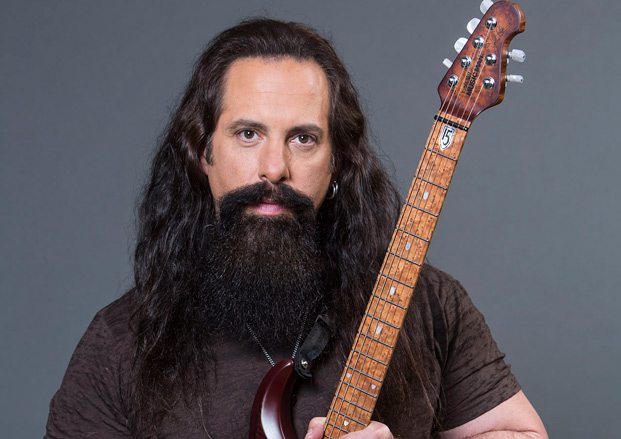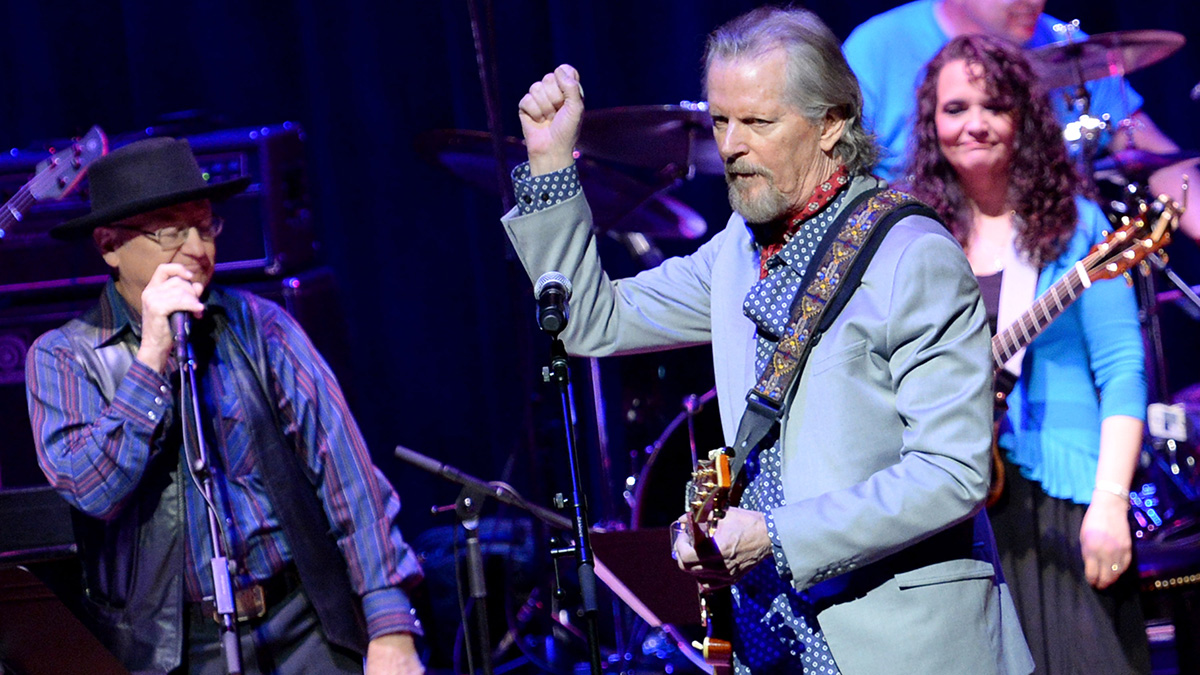
John Petrucci lets out a warm, self-deprecating laugh when I remind him of his opening remark in his first Guitar World cover story in November 2013: “Complacency is the enemy.”
“Clearly, I live by those words,” he says. “This album is the realization of that quote. It’s like, ‘What could happen if you had this very big idea?’ And the funny thing is, having the big idea is the easy part; seeing it through is where the hard work comes in. Fortunately, everybody in Dream Theater kept their goals in mind and stayed focused, and we achieved what we wanted to do.”
He pauses, then re-emphases, “It was a lot of work, though.” The album that Petrucci refers to is The Astonishing, which even by Dream Theater standards is something of a megaton explosion in both size and scope.
Over the course of their 30-year career, the five-piece progressive-rock titans (Petrucci, singer James LaBrie, bassist John Myung, keyboardist Jordan Rudess, along with still-relative new guy, drummer Mike Mangini) have always done things in a big way—“Illumination Theory,” from their 2012 self-titled album, clocked in at over 20 minutes, and the title track of their 2002 double album Six Degrees of Inner Turbulence came in at just over 42 minutes—but The Astonishing is something else altogether, a sprawling, 34-song concept album spread out over two hours and 10 minutes on two CDs, one that Petrucci, who also produced, envisioned as a stand-alone show to be performed live in its entirety.
“It’s a lot to take in,” Petrucci says with a chuckle. “You have to kind of sit down and clear your mind, like you’re going to watch Lord of the Rings. But you know, when I presented the idea to the guys, right from the get-go, they weren’t daunted. They were like, “Yeah, this is awesome. Go for it. Let's do it.” Not one person said, “Eh, I don't know about this…” That was very encouraging to me, because I knew I was going to be asking a lot from everybody. They saw me in the back of the bus, in hotel rooms and on planes, writing every second I could, working on the story. Their support was just incredible.”
Petrucci weaves a bold and elaborate fantasy-oriented plot throughout The Astonishing—the CliffsNotes version is that it’s set in a retro-futuristic post-apocalyptic dystopia in which a group of oppressed rebels rises up to overthrow an evil empire. (And in true rock-opera tradition—with even an unintentional nod to Footloose, too—music is banned in Petrucci’s grand narrative.)
“It is a complicated story,” the guitarist admits. “Part of the big idea was that it always could be more than just an album or a Dream Theater show. It could be a novel. It could be a movie or even a stage musical. It could be all of these different things. That's part of this creative vision that I had, to make something that was bigger than we’ve ever done before.”
Get The Pick Newsletter
All the latest guitar news, interviews, lessons, reviews, deals and more, direct to your inbox!
Below, we present an excerpt from our interview with Petrucci. For the complete feature and more, be sure to check out the March 2016 issue of Guitar World.
A few years ago, you said that you were working on a solo album. Did that fall by the wayside because of the Astonishing project?
Totally. As soon as we were done with the previous world tour, Jordan and I went into the writing for this album. There was no hole in the schedule, so I couldn’t find the time to continue with the solo record. It wasn’t for lack of material or interest—just no time. Anything that's recorded for the solo album is still in demo form. In fact, I played three of the songs on the last G3 tour I did in South America.
Hopefully, one day I can get into the studio and get it done. Even though you seem like a pretty driven guy, does something as big as The Astonishing take over your life? Did you drive your wife crazy when you were working on it? [laughs] Well, I'm lucky because Rena, my wife, is extremely supportive and helpful to me. I mean, sure, this record was a big undertaking, and I…I wear it, you know? But Rena’s a musician too, and because we've known each other for so long, she's very intuitive to what I'm thinking and feeling, and she helps out so much. If I come home and I’m stuck on something and want to bounce it off of her, you know, she’s there.
Even in the case of finding the artist who did the artwork for this album, she helped out there, too. We had been searching for the right person for a while, and it was a very specific kind of look that I had in my head; we had reached out to a whole bunch of different artists, but none of them were exactly what I was looking for. The next thing I know, she's online doing searches, and she found the artist who we ended up using. For me to have that teamwork and support in my own home from Rena is really amazing. Like you said, it can take over and consume you. She gets that and understands it.
Pete Townshend wanted to follow Tommy with a rock opera called Lifehouse. He wound up scrapping it, and the Who recorded Who’s Next as a regular record. Did something like this ever occur to you?
It didn't occur to me during this process, no. Once I dove in, there was no turning back. There were several moments when I thought, What? Are we out of our minds? I kept using the phrase, “It's like climbing a mountain.” It's like you're at the bottom of Everest and you need to get to the top. It’s daunting. But no, there was never a thought of “Let's turn back.” It was always forward thinking. That said, after this whole thing, when everything is said and done and this album is out and the world tour is over, yeah, we might do a regular album.
Rush’s Clockwork Angels had a dystopian sci-fi plot to it. What is it about that kind of setting that seems to capture musicians’ imaginations?
I think it's the idea that dystopia is a product of something that went wrong now. The idea of the way we're living now and taking some specific aspect of that and thinking, What would happen if this got out of control? Fast forward 100, 200, 300 years, and that's where that dystopia comes from. Life doesn’t go on as usual. If you go backward in history 100 or 200 years, you wouldn't call now a dystopia. Now is just a progression of where we were, and so you assume that's what the future will be like. I think it's a really interesting premise, and there's so many movies that come into play.
A Clockwork Orange, The Hunger Games, Mad Max, Escape from New York—there's tons of them. In this case, this story is set about 300 years into the future, and there was a societal breakdown and things go back to the way they were back in feudal times. If you take just where we live in North America, instead of there being countries and states, now there's empires and tyrants who rule over the land. Everybody else is a peasant, and they work for the emperor. My dystopian premise was in the way that robotics are taking over a lot of human jobs—everything from just assembly-line stuff to even self-driving cars. I thought, What if that happened with music and art? It’s like, humans don't make music anymore because it’s made by machines.
That's what’s on the cover, the ‘NOMACS,’ or noise machines, and that's what led to the breakdowns. In the story, in a far-off area of this new empire, somebody is born who has the gift of music, and that's the character Gabriel. He prompts a revolution, and that's where the story begins.
Let's get into some of the songs. “The Gift of Music” features a very lively and elastic extended instrumental section, but the backbone of the song is the riff.
Yeah, I’m really happy with that one. Do you go through various iterations of a riff before you say, “That's the one”? A little bit. The cool thing is that sometimes a riff comes out the first time you start to play it.
That riff is based off of what was happening in the story. I thought at that point, if you heard the overture, and you hear all of the different themes that are going to happen, this is the first vocal introduction from the narrator, Arhys. So I thought that the riff had to be energetic, lively and positive. I just picked up the guitar and played that riff. It took a little crafting to get it exactly the way I wanted it, but the crux of the riff came right as soon as I had the melody and the conceptual idea. Actually, in a bigger sense, having the story to write music to was really liberating, because sometimes you might sit down to write a song and you have no idea what to do.
There was never that case here—I knew exactly what to do.
I hear a certain Steve Howe influence in both the acoustic and electric playing in “A Life Left Behind.” Do you get that, or is that just me?
Definitely. There's something about the whole intro to that song, which is something I rarely do, if ever. I'm not sure if I’ve ever done it, but it's all played on acoustic. Even though it's progressive and there's a lot of notes and it's moving, I would normally tend to play that on electric. But that whole first intro part is all done on acoustic guitar. I think that guitar sound definitely has a Yes/Steve Howe influence, for sure, especially how it’s coupled with the piano and the kind of vocal sounds coming from the synth. Even the single-note arpeggios done in harmony with the piano, that's a very Yes sound.
And there’s no guitar solo.
No guitar solo on that song. [laughs] There are 34 songs on the album, and not all of them have guitar solos. Of course, you've got to have guitar solos…because you just have to. It's fun. It's a big part of what I do as a guitar player, and it’s a part of the style of music that we like to write. But in this case, there's no solo. The beginning makes up for it because it's all that acoustic playing, and that’s very challenging.
For the complete interview and more, check out the March 2016 issue of Guitar World.
Joe is a freelance journalist who has, over the past few decades, interviewed hundreds of guitarists for Guitar World, Guitar Player, MusicRadar and Classic Rock. He is also a former editor of Guitar World, contributing writer for Guitar Aficionado and VP of A&R for Island Records. He’s an enthusiastic guitarist, but he’s nowhere near the likes of the people he interviews. Surprisingly, his skills are more suited to the drums. If you need a drummer for your Beatles tribute band, look him up.











